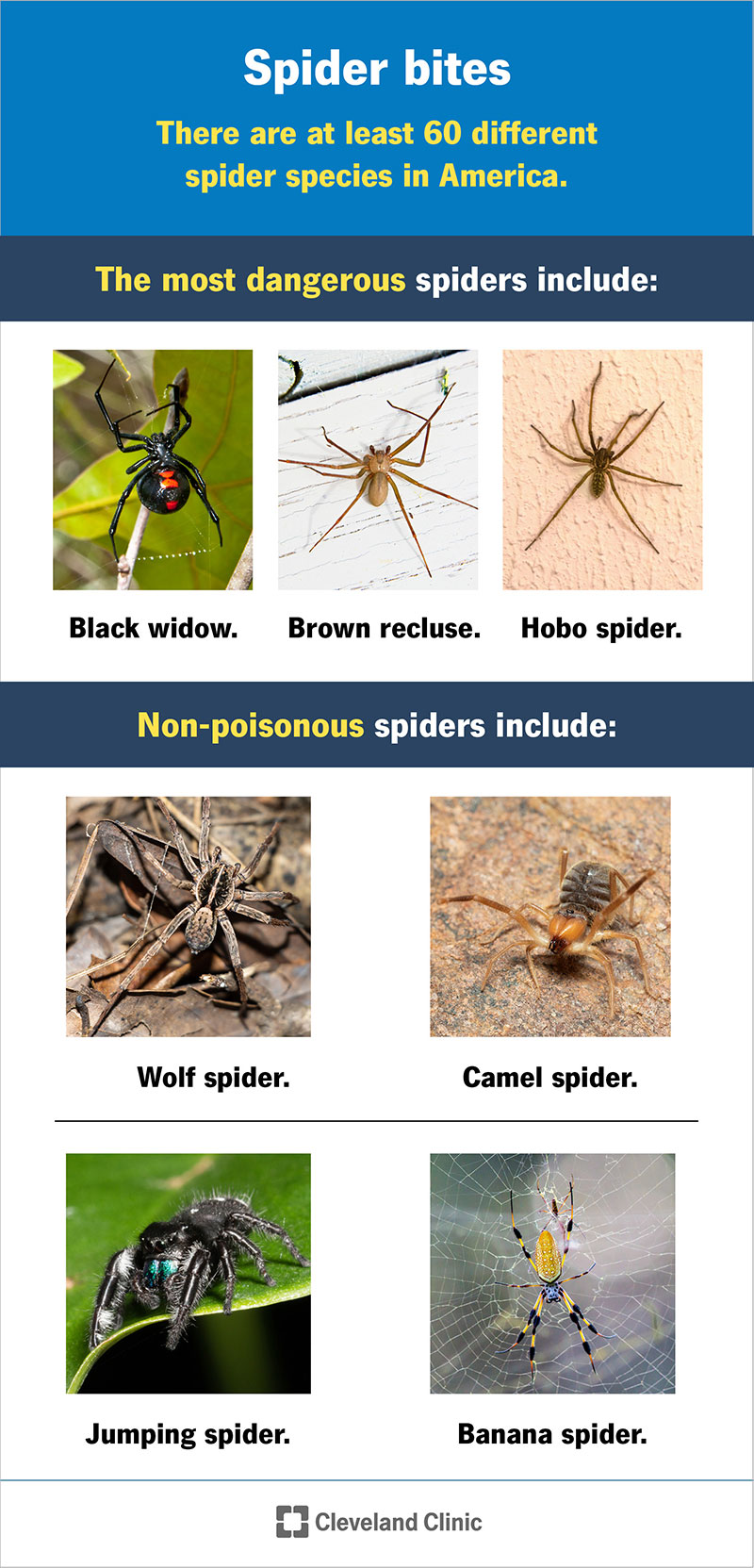Most spider bites only rarely cause serious problems. You may have redness, swelling and pain in the bite area. Bites from black widow, brown recluse and hobo spiders are more serious. They may cause trouble breathing, a severe headache and painful muscle cramps that require immediate medical care. You can take steps to prevent spider bites.
Advertisement
Cleveland Clinic is a non-profit academic medical center. Advertising on our site helps support our mission. We do not endorse non-Cleveland Clinic products or services. Policy

Spider bites — especially bites that can harm humans — are rare. All spiders make venom (a poison) that they use to paralyze and kill their prey. But most spiders aren’t aggressive to people, and their fangs are too small to puncture human skin. Spiders usually only bite humans when they feel threatened, like when you trap them or unintentionally make contact with them.
Advertisement
Cleveland Clinic is a non-profit academic medical center. Advertising on our site helps support our mission. We do not endorse non-Cleveland Clinic products or services. Policy
For the most part, spiders perform a vital function by eating insects that can destroy crops.
There are at least 60 different spider species in America, but only a few pose any danger to humans. These more dangerous spiders include:
There are almost 50,000 different spider species around the world. While most spiders are too small and their venom too weak to cause any danger to humans, they’ll still bite when they feel threatened. In the U.S., nonpoisonous spider bites include:
Advertisement
Experts aren’t sure how many people get spider bites every year. Most of the time, you may not know a spider bit you. Or you may think an insect bit you, instead of a spider.
Bites from black widows or brown recluses are most dangerous to children (because of their small size) and people age 60 and older (who may be weaker or in poor health). In the U.S., fewer than 3 people die every year from a spider bite. Most of these deaths occur in children.
Spider bite symptoms vary depending on the type of spider.
Black widow spider bites cause an immediate, sharp, pinprick-like pain. The bite area then becomes numb. Other signs of a black widow spider bite include:
Brown recluse spider bites aren’t immediately painful or noticeable. Instead, you might feel pain an hour after the bite. Other signs of a brown recluse spider bite include:
Advertisement
Hobo spider bites rarely cause pain. Signs of a hobo spider bite include:
If you’ve been bitten by a spider, you may see a set of tiny fang marks where the spider broke your skin. You may have a small bump or a blister at the site. In addition, you may notice mild swelling and redness or skin discoloration.
Spiders aren’t typically aggressive toward humans. Bites occur when spiders feel threatened and need to defend themselves.
Anyone can accidentally come into contact with a spider and get bitten. Still, some people may be more at risk because their jobs or actions put them in closer contact with places where spiders live. People at risk include:
Some brown recluse bites cause a skin ulcer (wound). If the wound doesn’t heal, you might need surgery.
Black widow bites are the most serious. Children under 16 and people older than 60 may need hospitalization to treat:
Advertisement
Seeing the spider is the best way to confirm both a bite and the type of spider. Otherwise, there isn’t a way to test for a spider bite or determine what bit you.
Your healthcare provider may make a diagnosis based on your symptoms. Your provider may also send a sample of fluid from a blister to a lab to check for skin infections that cause similar symptoms, such as methicillin-resistant staphylococcus aureus (MRSA).
Spider bite treatment will vary depending on your symptoms and the type of spider that bit you.
Treatment for black widow spider bites may include:
Treatment for brown recluse and hobo spider bites include:
You should never attempt to suck out or remove venom from a spider bite. Instead, follow these steps:
Advertisement
Most people with spider bites experience mild symptoms like pain and swelling. These symptoms gradually go away with at-home care.
You may have more painful and severe symptoms if a black widow, brown recluse or hobo spider bites you. With proper medical care, most people recover from venomous spider bites.
To protect yourself and your family from spider bites:
You should call your provider if you experience:
If you have concerns about a spider bite, you may want to ask your healthcare provider:
Spiders get a bad rap, but they provide a helpful service by reducing the number of insects on the planet that could destroy crops and land. Spiders really don’t want to bite you. They only bite when they’re trapped or feel the need to defend themselves. Most spider bites are harmless. Your healthcare provider can offer suggestions for alleviating symptoms at home. You should seek immediate medical attention if a black widow, brown recluse or hobo spider bites you, or if you’re noticing symptoms of these bites, as most people who get bitten don’t see the spider.
Need care fast? Cleveland Clinic’s Express Care and Urgent Care locations treat everything from sprains to sinus infections — no appointment needed.

Last reviewed on 04/23/2024.
Learn more about the Health Library and our editorial process.